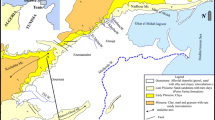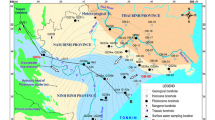Abstract
Chemical data are used to clarify the hydrogeological regime in the Merdja area in Tébessa, as well as to determine the status of water quality in this area. Groundwater from the aquifer in the Merdja area can be divided into two major groups according to geographical locations and chemical compositions. Water in the center part of the area of study is characterized by the dominance of chloride, sulfate, sodium, and potassium; whereas waters in the limestone aquifers in the west are dominated by the same cations but have higher concentrations of bicarbonate. Stable isotopes show that the Tébessa aquifers contain a single water type, which originated in a distinct climatic regime. This water type deviates from the Global Meteoric Water Line (MWL), as well as from the Mediterranean meteoric water line. The water is poor in tritium, and thus can be considered generally older than 50 years. Piezometric map suggests that water is moving from the west towards the center of the studied area, and from east towards center. Degradation of water quality can be attributed to agricultural fertilizers in most cases, although the wadi El Kebir River is a contributor to pollution in the middle part of the studied area.











Similar content being viewed by others
References
Blés JL, Fleury JJ (1970) Carte géologique de l’Algérie au 1/50000: feuille n°178, Morsott, avec notice explicative détaillée. Service de cartes Géologique et Sonatrach, Division d’hydrocarbure. Direction des explorations, Alger, Algérie
Djabri L (1987) Contribution to the hydrogeological study of the subsidence plain of Tebessa NE Algeria. Attempt of modelling. Doctorate Thesis, University of Franche Comté, France
Edmunds WM, Shand P, Guendouz A, Moulla AS, Mamou A, Zouari K (1997) Recharge characteristics and groundwater quality of the Grand Erg Oriental basin, final report. EC (Avicenne), Contract CT93AVIOOI5, BGS Tech Rep WD/97/46R, Hydrogeology Ser
Girard P, Hillaire M, Oga MS (1997) Determining the recharge mode of Sahelian aquifers using water isotopes. J Hydrol 197:189–202
Guendouz A, Moulla AS, Remini B, Michelot JL (2006) Hydrochimical and isotopic behaviour of a sahara phreatic aquifer suffering sever natural and anthropic constraints (cas of Oud-Souf region, Algéria). Hydrogeo J 14:955–968
Parkhurst DL, Apello CAJ (1999) User guide to PHREEQC (version 2)—a computer program for speciation, batch reaction, one dimensional transport, and inverse geochemical Calculations: U.S. Geological Survey Water Resources Investigations Report: 99–4259, 312 p
Plummer LN, Jones BF, Trusedall AH (1976) WATEQ—a Fortran IV version of WATEQA computer program for calculating chemical equilibrium of natural waters. U.S Geol-Surv. Water Res, Washington DC, vol 76, pp 13–61 (Revised 1978, 1984)
Rouabhia A, Baali F, Kherici N, Djabri L (2004) Vulnérabilité et risque de pollution des eaux souterraines de la nappe des sables miocènes de la plaine d’El MA EL Abiod (Algérie). Rev Sécheresse 15:347–352
Rouabhia A (2006) Vulnérabilité et risque de pollution des eaux souterraines de la nappe des sables miocènes de la plaine d’El MA EL Abiod (Algérie). Doctorat Thesis, University of Annaba, Algeria
Sawyer C, McCarthy P (1967) Chemical and sanitary engineering, 2nd edn. McGraw-Hill, New York
Todd D (1980) Ground water hydrology, 2nd edn. Wiley, New York
Vila JM (1980) La chaîne alpine de l’Algérie orientale et des confins Algéro-Tunisiens. Thèse de Doctorat ès sciences, Université Pierre et Marie curie, Paris VI
Water Authority (North Jordan resource investigation project stat) (1989) Yarmouk basin water resources study, draft final report
WHO (1998) Guidelines for drinking water quality. Addendum to vol 2, 2nd edn. Health criteria and other supporting information (WHO/EOS/98.1), World Health Organization
Wilcox L (1948) The quality of water for agricultural use. US Dept Agriculture Tech Bull 962, Washington DC
Acknowledgments
The authors thank the anonymous reviewers for their constructive comments. This work has been realized through the framework of CNPRU project G02920070001. We would like to thank Profs. Bouchaou L. (Morroco) and Zaoui A. (France).
Author information
Authors and Affiliations
Corresponding author
Rights and permissions
About this article
Cite this article
Rouabhia, A., Fehdi, C., Baali, F. et al. Impact of human activities on quality and geochemistry of groundwater in the Merdja area, Tebessa, Algeria. Environ Geol 56, 1259–1268 (2009). https://doi.org/10.1007/s00254-008-1225-0
Received:
Accepted:
Published:
Issue Date:
DOI: https://doi.org/10.1007/s00254-008-1225-0




